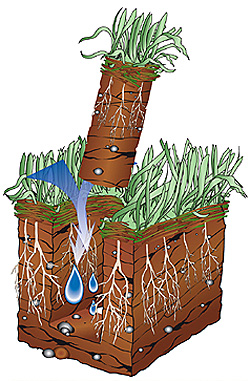Why aerate my lawn?
Lawn aeration is generally recognized as the best way to improve air/gas exchange and water/nutrient intake. Some aeration occurs naturally, but due to soil compaction or other soil conditions, lawns rarely thrive without some means of mechanical aeration.
In addition to compaction, thatch build-up (more than 1/2 inch) can be especially damaging to lawns. It acts as a barrier, preventing water and nutrients from getting into the soil.

Mechanical Aeration benefits your lawn in six ways: 
- Reducing soil compaction
- Penetrating heavy thatch
- Allowing more efficient watering and fertilizing
- Enhancing root growth
- Enriching surface soil
- Decreasing water run-off
Many years ago, crude aeration was accomplished by poking holes in the lawn with a pitchfork or other pronged device. Today, we have the advantage of mechanical aerators that actually remove small-diameter “plugs” from the soil.
The holes left in the turf allow moisture and nutrients to more easily reach the roots. As the soil naturally expands to fill the holes over a few weeks’ time, the surrounding soil is allowed to loosen, reducing compaction.
The “plugs” are scattered on the surface and eventually break down to form a valuable top dressing that enriches soil near the surface and helps break down thatch.
Aerating tips
When should I aerate?
For most grasses, the very best time is just prior to, or early in the fast growing season. However, cool-climate grasses, like Bluegrass or Fescue, can be aerated in the early spring or fall, while warm-climate grasses like Bermuda or Zoysia need to be done mid-spring to early summer.
How many holes are needed?
In order to ensure thorough aeration, experts recommend at least nine holes per square foot of lawn and as many as 16 per square foot in some types of clay or other densely compacted soil. This may require going over your yard several times. Aeration holes should be two to three inches deep for maximum value.
What about fertilizing?
An application of fertilizer, along with heavy watering just after aeration, will greatly stimulate root growth. Deep watering every two or three days, for a few weeks after aerating, will cause the roots to grow deeper for increased strength during dry times.
Can I seed at the same time?
Yes. Combining aeration with seeding is an excellent idea. Aeration loosens up the soil, giving new plant roots “room to grow.” This applies to overseeding existing turf or planting new grass.
What about weeds?
Studies show the pre-emergent applications are not affected by core aeration. Weed seeds on top of the pre-emergent barrier will not grow down through the barrier, nor will weeds grow “sideways” toward the aeration holes. Feel free to aerate before, during, or after treating for annual weeds (such as crabgrass).
What should I expect?
Keep in mind, lawn care is a long-term process requiring regular maintenance. While aeration can provide dramatic results, don’t expect miracles from a single aeration. The benefits of improved fertilizer absorption, better rooting, and thatch breakdown will result in a greener, healthier lawn over time.




